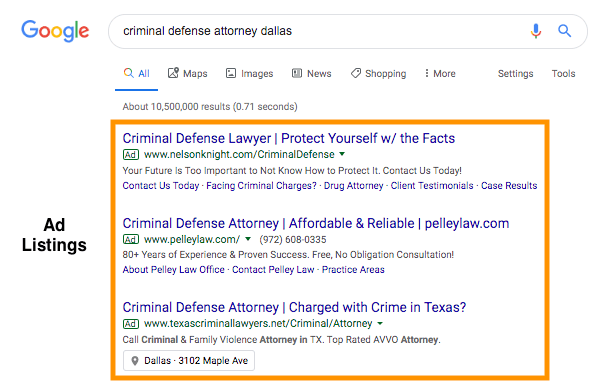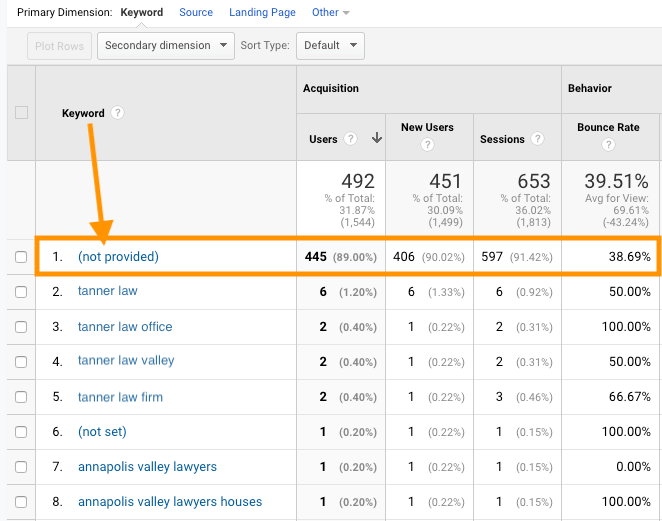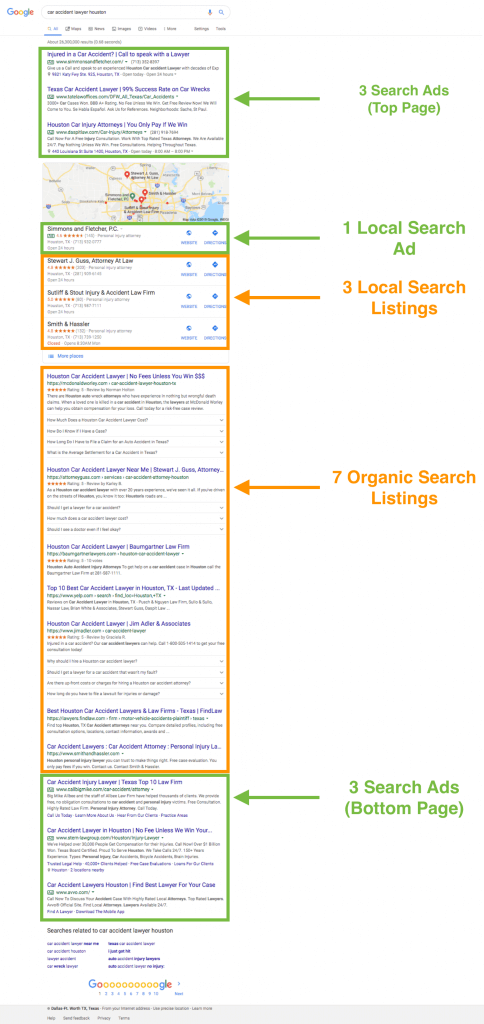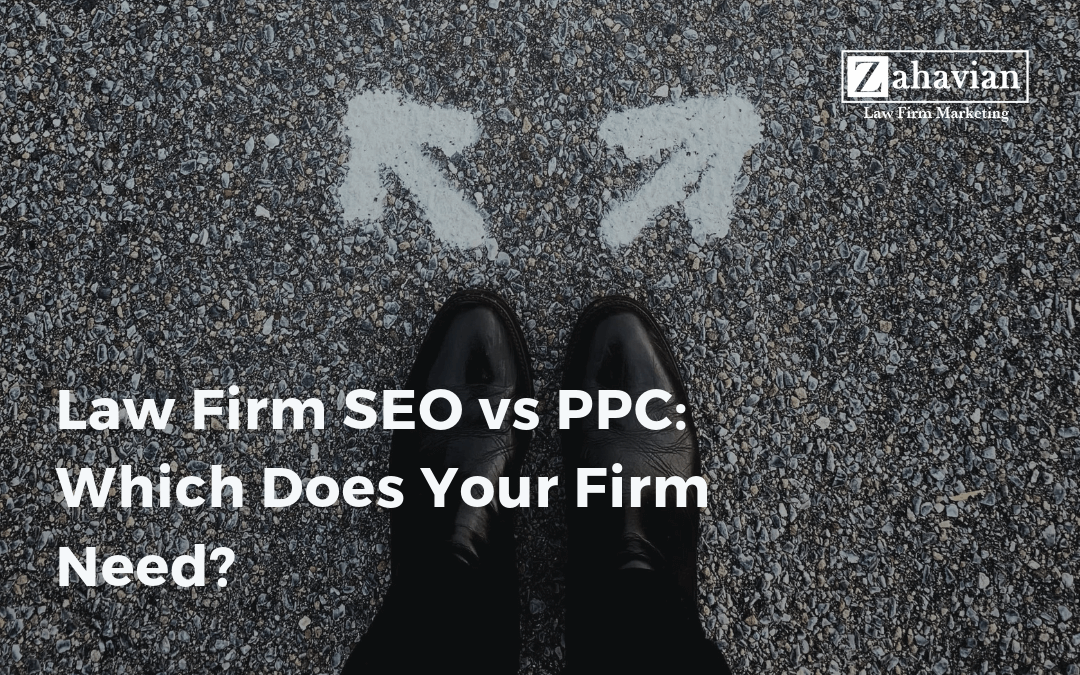When it comes to law firm marketing, the internet proves to be an increasingly valuable channel for law firms to generate new leads and cases. With that said, internet marketing spans a wide range of channels and strategies on its own. Two of the largest strategies include SEO and PPC. Many firms have benefited handsomely from it, while others are still looking to find the right partners or methods of successfully implementing one, the other or both strategies.
Is PPC or SEO better for law firms seeking to generate leads and cases? Typically, where both SEO and PPC produce equal amounts of traffic to the same page(s) on a website, organic traffic (SEO) will produce more legal clients and leads than PPC.
But wait…!
The answer between the two isn’t so simple and straight forward. First of all, PPC itself represents a broad category of different ads.
- Which PPC platforms and types of ads is your legal practice using?
- What audiences or keywords are you targeting with these ads?
- What SEO strategy is your law firm using?
These questions only begin to scratch the surface. We can’t get into all of it in one article, but we’re going to look at:
- Some results from both organic and paid traffic
- When PPC, SEO or both make sense for your firm
- The Pros and Cons of each
- Benefits of using both for your law firm
In this article, we’re going to look in-depth at:
- How leads are driven from organic vs. PPC traffic
- Quality of PPC channels and how this impacts CVR and # of leads
- Metrics to understand CVR and leads from organic traffic and PPC channels
Does SEO or PPC Drive More Leads and Clients?
Generally, organic traffic drives more leads. Organic traffic refers to traffic you get from search engines without paying for it through ads. This is the organic results you’ve probably heard and seek out when you perform a Google or Bing search. This process of optimizing your website to acquire as much relevant, organic traffic as possible is known as SEO (Search Engine Optimization).
If your site is linked with an analytics tool, such as Google Analytics, it becomes fairly easy to see whether leads are driven through organic or PPC channels. This assumes that you have set up your goal and conversion tracking.
This screenshot above was taken from one of our law firm client’s Google Analytics accounts, over the course of a month, at which time, we were running a relatively small Display Ads campaign for them. Take note, that we’re testing audiences for them and therefore only running a small budget to test before scaling their campaign.
However, this example works very well for understanding what some typical PPC advertising results look like in the legal industry. Keep in mind this is not AdWords (search engine marketing PPC ads). Instead, this PPC campaign used banner ads that are displayed on third-party websites.
What’s interesting to note is that the traffic driven to their law practice’s website from the display campaign is just slightly larger than the organic traffic for that period (353 paid/PPC users vs. 327 organic users).
However, take note of the relatively small number of paid traffic conversions relative to users organically finding the site through search engines like Google and Bing. There are several points of interest here. Organic traffic produced 1376% more goal completions than paid traffic and generated 2265% more in terms of traffic value ($29,450 vs. $1,300).
Note: this does include brand searches for the firm – as brand building is very important. However, a significant share of this still comes from target keywords from people searching for a law firm like this one.
Traffic Value per User
This law firm’s website produced $37,500 in traffic value from goal completions across 1,087 users over the course of a month. That means, on average, every visitor generated $34.49 in value for their business.
SEO & Organic Traffic Value to the Law Firm – Just taking the traffic value for just organic, that works out to $29,450 over 327 users. That yields an average value per user of $90.06 compared to $3.68 per user from paid traffic channel (Display ads campaign) for the same analytics reporting period. To be fair, if we dug really deep into the story. The paid traffic channel’s conversions could be producing some wildly profitable cases for this firm that simply isn’t being taken into account by the analytics.
In fact, part of the purpose of this campaign was to generate more of the high-value cases for this law firm.
That leads us to the next point, in how these leads are being measured.
How Is It Measured?
I left off by mentioning that the metrics may be treating the PPC campaign a little too unfairly. Whenever we use data and statistics to support our reasoning and findings, we need to understand how good or true the data is. The traffic value above is generated from a feature within Google Analytics appropriately named goals. Each goal can be assigned a dollar figure value or not.
For instance, a large part of the goal conversions, as you may have seen in the screenshots, include “Engage 5 mins” and “Engage 10 mins”. These are just quick, soft goals to let us know at a quick glance how long visitors are staying on and engaging with the site. They attribute $0 in traffic value.
Whenever someone clicks on the firm’s phone number to call or submits a contact form, those have fixed dollar goal values that contribute to the total goal value. These are estimated based on assumptions of how much a new case is worth to the firm and how many new leads (phone calls and form submissions) it requires to generate a new case.
Since the firm practices in different areas of law, some cases are worth thousands, in the five figures and other times six figures and up. Because of this, we set an average case value, based on how much the average new case is worth to the firm.
With the PPC ads to be fair, the display ad campaign, in this case, is targeting the higher value cases. So while the analytics calculations work out to be a small fraction of the organic traffic’s value, this is wildly underestimated compared to reality.
Why Organic Traffic Has a Higher Conversion Rate Than PPC?
When it comes to organic traffic versus PPC traffic and even Facebook, the first thing you should compare is the Bounce Rate of the three channels. Facebook and Paid are extremely high at 85 and 88% respectively, compared to just 38% for organic. This means that the vast majority of people that visit the site from display and facebook ads are leaving the site almost immediately after landing on the page.
The reason all has to do with the behavior of the users coming to the site from these different channels. One may think that the user experience is poor. However, if that were true, then the organic traffic bounce rate should arguably be higher and closer to the other two channels, which share an almost identical bounce rate. Organic’s bounce rate is approximately 50% lower, though. This is because, when people visit the site through organic search, they are actively looking for the site or a website like this one.
Traffic from paid and social media will be due to a variety of reasons. First off involves unintentional clicks. This is particularly true of touchscreen devices like phones and tablets. The second is due to the environment.
Display ads are shown on YouTube, mobile apps, and third-party website with ads embedded on them. So when people visit this website from one of those sources, it interrupts what they were previously doing.
The same can be said about visitors coming from social media sites and apps like Facebook. Hence, a considerable amount of the bounce rate can be attributed to them clicking the back button on their browser or closing the new window.
Conversion Rates Depend on the Type of PPC Ads
While the premise above has been that organic traffic generally pulls in far more conversions and leads that PPC campaigns, it truly depends on the type of PPC campaign and optimizations made to it. Running a PPC campaign involving Facebook ads, Google Display or banner ads will typically generate significantly lower conversion rates than organic search traffic.
However, when running a well-optimized and managed search engine marketing (SEM) ads campaign, the results can be quite similar to organic. This is because of the visitor’s intent. Typically when running a banner ad or Facebook ad, visitors are coming from other platforms, which means they are being interrupted or diverged from their previous activity to visiting your practice’s website. When they click on an ad in the search results of Bing or Google, it’s because the ad is highly relevant to the search query they performed. Therefore, they’re not being interrupted or distracted, rather being presented information that they intended to search for at that moment. This is known as visitor or user intent.
On Facebook or third-party websites with ads, the user intent is low when they click on an ad. In some cases, they didn’t intend on clicking on the ad at all. When performing a search and clicking on either an organic search result or SEM ads – which looks almost identical to an organic listing – this is known as high or relevant user intent. Therefore, they are much more likely to convert or contact your business as a result of performing a search and seeing an SEM ad, instead of some other type of PPC ad with lower user intent.
Lawyer SEO vs. PPC: Advantages & Challenges
To better understand which is right for your legal practice, it’s best to break down the two forms of web traffic into their benefits and disadvantages. As this comparison shows, the two actually are fairly contrasting in their core features and why a business would want to use them.
There are many forms of PPC. So to level the playing field, this comparison will focus specifically on search engine ads, such as Google AdWords (example shown below). Banner and image ads, such as those discussed in other parts of this article do share similarities, but SEM ads share the closest similarities to organic search results since they appear on the same page in search engines such as Google and Bing.

While they look very similar, understanding how they work and what problems they can solve for your business can be illustrated by observing these differences.
| Organic Traffic via SEO | Paid Traffic via PPC Search Ads | |
| Pros | 1. “Free” Traffic from Organic Rankings 2. Improve keyword visibility at all levels of funnel and client journey to hiring a lawyer 3. Higher volume of relevant traffic | 1. Page 1 visibility immediately 2. Granular control over keywords and search exposure 3. Comprehensive data & reporting 4. Highly scalable 5. Can see results quickly |
| Cons | 1. Rankings not guaranteed 2. Takes time to see results 3. Long-term investment to rank for high-value keywords 4. Difficult to know what keywords generate the most valuable traffic and leads | 1. Expensive; High CPC 2. Lower CTR and traffic 3. Only appropriate for bottom-funnel search queries and keywords |
Organic Traffic from SEO
SEO Advantages
- “Free” Traffic from Organic Rankings: Once your website’s content and pages start ranking, you don’t have to pay to generate all of this virtual foot traffic and brand impressions.
- Improve keyword visibility at all levels of funnel and client journey to hiring a lawyer: One of the biggest advantages to SEO is being able to create valuable content that targets people at all stages of their journey before hiring a lawyer. You can provide free information for them regarding their legal matters, which they are searching for. In return, you’ll acquire more clients and cases at the top, middle, and bottom of the funnel.
- Higher volume of relevant traffic: Many people that use search engines like Google can tell the difference between the ads and organic results. As a result, far more people click on the organic results as they feel these listings are more trustworthy than the ads.

SEO Disadvantages
- Rankings not guaranteed: There’s no guarantee that your website will rank in the top 10 positions (page 1). In fact, your rankings can go down. It all depends on the search engine optimization ‘experts’ you hire and the on- and off-page SEO work performed on your firm’s website.
- Takes time to see results: After content is published, optimizations have been made to pages and the site, there’s a lot of waiting involved. It can take 3-6 months to start experiencing results. If results are sub-par or don’t indicate that they don’t meet projections, re-performing optimizations could take more time to see results from again, making this a laggy and long process.
- Long-term investment to rank for high-value keywords: the most high-value keywords that most lawyers want to see their website appear in the first-page results for are very competitive. Many other firms in your market are chasing the same keyword results. This can take 3-12 months to rank. Even once you do, you’ve knocked another attorney out of the top 10 and they’ll likely want to regain their lost rankings.
- Difficult to know what keywords generate the most valuable traffic and leads: When doing reporting, the majority of the information that generates leads, phone calls and other valuable actions that lead to new business can be tracked and delivered in reports. However, when trying to figure out exactly which SEO efforts – by measuring which search terms lead to people finding your business and converting into leads – a lot of that data is marked as “not provided.”

Paid Traffic from PPC Search Ads
PPC Advantages
- Page 1 visibility immediately: Similar to SEO, the objective is to get visibility on the first page and generate traffic that yields new leads from that exposure. With AdWords PPC, your firm can start showing up on relevant search queries almost immediately. New campaigns under good management may take several days to set up, to protect your firm’s reach and exposure on search engines, but this is merely smart AdWords management necessary to protect your investment. Once performed and bids are set accordingly, your ads will be reaching a small, but a hyper-relevant audience.
- Granular control over keywords and search exposure: PPC and search engine marketing ads, like AdWords, allows businesses to be extremely explicit and granular over which searches they appear in. In the cases where an ad was displayed to a semi-relevant or less desirable case type for your law firm, you can easily ‘blacklist’ the keywords contained in that search from being included in future searches that your ads appear in. Alternatively, you may want to target those keywords and cases, but focus a smaller portion of your PPC budget on it. This is also easily achievable in AdWords and PPC.
- Comprehensive data & reporting: Unlike SEO, where many of the keywords that drive leads and conversions are marked “not provided”, this problem doesn’t exist with SEM platforms like AdWords. Businesses are able to see exactly what keywords and search terms convert visitors into leads best and which one performs the worst. This allows for much quicker tuning and optimization of PPC and AdWords campaigns than an SEO campaign.
- Highly scalable: One of the greatest advantages of PPC ads is that once you see success with a certain campaign and you want to increase your business’s results from it, many times you can simply increase the budget to scale it. Typically, once performance reaches a saturation point based on budget spend, there are other ways to scale the campaign. This is usually achieved by expanding certain limits or constrained criteria on audience targeting.
- Can see results quickly: Probably the top advantage that will inform a decision for a lawyer to start using PPC ads and AdWords for their practice is how quickly they can see results from it compared to SEO. SEO requires a lot of upfront investment and waiting. With an AdWords campaign, you’re going to see traffic start coming in, then some phone calls and lead form submissions. Once a handful of those roll in, you’ll begin seeing that translate into intakes and appointments.
PPC Disadvantages
- Expensive, High CPC: AdWords PPC can work wonders when targeting specific legal keywords that are highly related to the types of cases you want to attract the most. However, you’re likely not alone in this and many other law firms are competing to have their ads appear in the search results as well. Because Adwords and many forms of PPC use a bidding system, this raises the price to compete for this traffic, known in PPC and CPC (cost per click). Attorneys advertising for these keywords in search results can typically expect to spend anywhere from $5 per click up to several hundred dollars per click in more competitive areas of practice such as personal injury and criminal defense.
- Lower CTR and traffic: Using search engine ads can be a great way to generate new clients and drive relevant traffic to your website. However, the click-through rate (CTR) and hence the traffic that one can drive from ads is much lower than from organic results. As shown in the image above, clicks on search ads are typically only in the single digits, whereas local and organic result listings account for over 90% of all clicks on search results.
- Only appropriate for bottom-funnel search queries and keywords: There are different types of keyword categories. Very few of them are actually what is referred to as bottom-funnel or ‘hot’ keywords, meaning keywords and search terms people use when they’re ready to transact with a business. Many keywords are top or middle of the funnel, which is when people are conducting research about their legal issue. This constitutes a benefit and a disadvantage as SEM ad campaigns should be geared toward the transactional keywords that will produce leads and appointments. However, it would be expensive to advertise to them earlier in the funnel and their journey towards hiring a lawyer and becoming top of mind with them.
Why Use SEO & PPC Together for your Law Firm
Now that the key advantages and disadvantages of SEO and PPC have been described, it may be clearer now that the two methods are highly contrasting and their key differences are nearly polar opposites. What they share in common is that they’re both meant to get a business in front of a relevant audience in search engines. These differences actually represent a very cohesive and complementary relationship between the two. Below are some of the major reasons why a legal practice may want to use both instead of simply choosing between one and the other.
Get More Leads by Dominating Page 1
The reason to invest in either SEO or AdWords is to get on the first page of the search engine results in Google or Bing, in order to generate more business for your law firm. However, when people perform a search, suppose for “car accident lawyer houston”, they’ll see a search results page like the following.

This search results page contains:
- 7 Ads (6 Search Ads + 1 Local Ad)
- 7 Organic Search Listings
- 3 Local Search Listings
For a total of 17 choices displayed to a user. While the local and organic listings get most of the clicks, ads still get clicks too. Using SEO and PPC, a law firm could occupy 3 of these 17 positions by having:
- Local Search Listing or Ad
- Search Ads Listing
- Organic Search Listing
A business showing up once on the first search results page is good. Having it appear 3 times on that page is great and will have a dramatic impact on the number of prospective clients calling that law firm.
Use PPC and AdWords Data to Make Better SEO Decisions
One of the disadvantages of SEO, as described earlier is that the keywords and search term data is far from complete. Many of the search terms are reported as “not provided”. However, search ads, like Google AdWords provides detailed reporting on which keywords received impressions as well as the specific search terms that produced clicks and conversions (i.e. phone calls, form submissions, etc.). Any data collected from running AdWords can then be used to understand which organic search keywords are most valuable to your practice. Once this is analyzed, it will provide valuable insights into where the most effort and investment should be placed on increasing and maintaining rankings.
Use Quality Score to improve SEO Rankings
Quality Score is a metric used in the AdWords auction to determine which ads should be displayed on the search results page as well as which order they should appear in. This is scored on a scale of 1-10, broken down by ad relevance, expected click-through rate and landing page experience.
While the organic search ranking algorithms are very different from ads, the overall goal of ranking in the ad listings or organically use a variant of these metrics. By taking this data from the search ads and carefully applying it to your law firm’s pages that are ranking in organic results, one can achieve better results.
Ad relevance can be used to optimize the meta description and title tag to match the most valuable keywords and search terms your law firm seeks to optimize for.
Expected Click-Through Rate can be used to specifically optimize title tags to make the titles more appealing and enticing to click on, attracting more visitors to click on your search listing rather than the competition.
Landing Page Experience should be used to guide the on-page content in terms of the copy, layout, and design. This ad score can give insights into what a high-quality web page should contain to keep the user’s attention and drive higher engagement.
Run Remarketing Campaigns on from SEO and PPC Traffic
Organic search and SEM ads traffic can have great conversions rates in the legal industry. It’s not uncommon for these to pull in between 5-20% conversion rates, depending on the area of practice, search relevance and other factors.
But what about the other 80-95% of visitors that don’t convert?
These visitors found your website, but for one reason or another, simply weren’t ready to contact your office. Some of them may return later, whether finding your website again or performing a branded search. However, the reality is that the majority of them won’t return.
But that doesn’t have to be your law firm’s reality.
A great way to increase your ROI and produce several additional clients is to run a retargeting campaign to them. After they’ve found your firm’s website – whether through paid or organic search – you can track them using Analytics or a Facebook tracking pixel. Then, you can run ads specifically to these segments of website visitors and show them ads periodically, following up with them to try to get them to convert when they’re ready to hire a lawyer.
Related Questions
How much does PPC Cost for Small Businesses? PPC ads vary in price depending on the type of ad. On average, Display ads cost between $0.50 and $0.80 per click. Search ads vary widely based on industry. Costs range from $5 per click for a plumber up to $100 per click for law firm ads.
What’s the difference between PPC and SEM Ads? PPC stands for Pay Per Click and describes the charge model for the majority of online advertising: only paying when the ad is clicked. SEM (Search Engine Marketing) ads are a subset of PPC, that only appear above the search results in search engines like Google or Bing.


